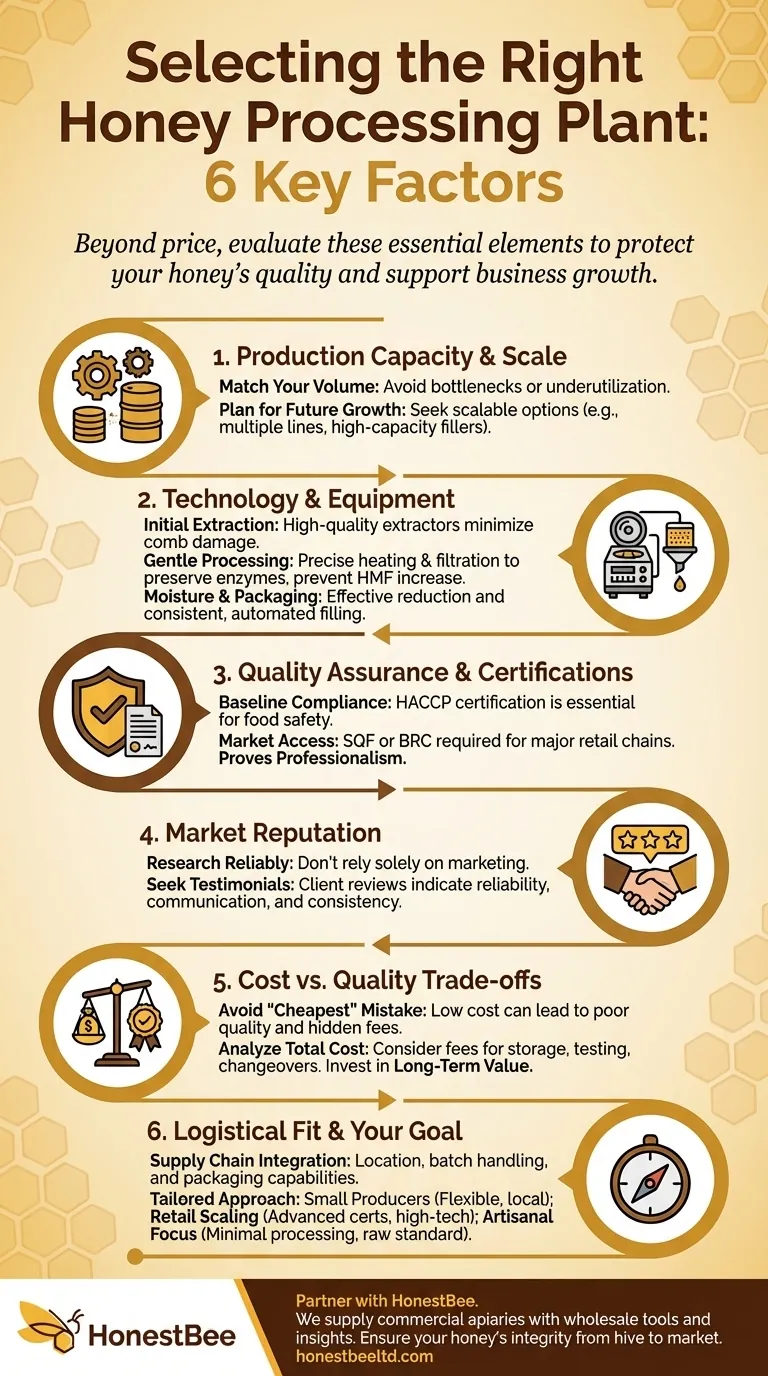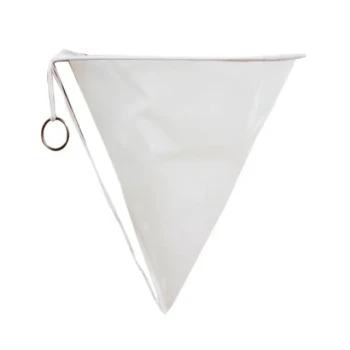To select the right honey processing plant, you must look beyond the price tag and evaluate six key factors: the plant's production capacity, the quality of its technology, its quality assurance certifications, its market reputation, the total cost structure, and its logistical fit within your supply chain. This evaluation ensures the partner you choose can protect your honey's quality and support your business's growth.
Choosing a honey processing plant is a strategic business decision, not just a logistical one. The right choice hinges on aligning the plant's capabilities—from its equipment to its certifications—with your specific production volume, quality standards, and market ambitions.

Assessing Production Capacity and Scale
The first step is a frank assessment of volume. A mismatch between your output and the plant's capacity creates significant inefficiency.
Matching Your Production Volume
A plant's capacity must align with your current and near-future production. Choosing a plant that is too small creates bottlenecks, delaying your product's journey to market.
Conversely, a plant that is too large may de-prioritize your smaller batches or charge un-economical rates, making them a poor fit for emerging beekeepers.
Planning for Future Growth
Consider your growth trajectory. A good partner should have scalable options, such as multiple production lines or the ability to handle larger volumes as your operation expands. For example, some plants offer both small-batch and high-capacity inline fillers (from 3 to 6+ tons per day).
Deconstructing the Technology and Equipment
The equipment used by a plant directly determines the quality, consistency, and shelf-stability of your final product. Understanding the core processing stages is critical.
The Initial Reception and Extraction
The process begins with the extractor, which uses centrifugal force to separate honey from the combs. High-quality, modern extractors perform this task efficiently without damaging the combs or introducing excessive air into the honey.
Filtration, Heating, and Moisture Reduction
Raw honey is gently pre-heated to improve its fluidity for filtering. This is a delicate step; excessive heat can destroy enzymes and increase hydroxymethylfurfural (HMF) levels, a key indicator of heat damage and a marker of poor quality.
The honey then passes through a filtration system to remove impurities like wax and debris. The level of filtration is a key detail—coarse filtering retains beneficial pollen, while ultra-filtration can remove it.
Some facilities also offer moisture reduction to ensure the honey's water content is below the ~18% threshold needed to prevent fermentation.
Homogenization and Packaging
A homogenizer may be used to ensure consistent texture, color, and quality throughout a large batch, which is crucial for brand consistency.
Finally, an automated packaging unit fills and seals containers. Look for efficiency, accuracy, and the flexibility to handle your specific packaging needs, whether they are jars, pails, or other formats.
Verifying Quality Assurance and Reputation
A plant's certifications and reputation are your guarantee of safety and reliability. They are non-negotiable proof of professionalism.
The Role of Certifications
Look for compliance with food safety standards. Certifications like HACCP (Hazard Analysis and Critical Control Points) are the baseline. Higher-level certifications like SQF (Safe Quality Food) or BRC (British Retail Consortium) are often required to sell to major retail chains.
Researching Reputation
Do not rely solely on the plant's marketing materials. Seek out client testimonials and reviews from other beekeepers or producers. A plant's reputation for reliability, communication, and consistent quality is a strong indicator of the experience you will have.
Understanding the Trade-offs: Cost vs. Quality
While budget is a major factor, focusing solely on the lowest price is a common and costly mistake. The "cheapest" option can easily become the most expensive in the long run.
Hidden Costs and Fee Structures
Analyze the entire cost structure, not just the per-pound processing fee. Ask about potential hidden fees related to receiving, storage, lab testing, packaging changeovers, or minimum batch sizes. A transparent partner will provide a clear and comprehensive quote.
The Long-Term Value of Quality
A low-cost plant may be using older, less-efficient equipment that degrades honey quality. It might also lack the certifications needed to enter lucrative markets.
Investing in a plant with modern, well-maintained technology and robust quality assurance protects your brand's reputation, ensures a premium product, and opens doors to wider distribution channels. This is an investment, not an expense.
Making the Right Choice for Your Goal
Your ideal processing partner depends entirely on your specific objectives.
- If your primary focus is entering the market as a small producer: Prioritize a local plant with flexible batch sizes and a reputation for working well with smaller beekeepers.
- If your primary focus is scaling up for grocery and retail chains: Prioritize a plant with advanced certifications (SQF/BRC), modern heating and filtration technology, and proven logistical efficiency.
- If your primary focus is maintaining an artisanal or "raw" honey standard: Prioritize a plant that offers minimal processing, such as coarse filtration and no pasteurization, and has experience preserving the natural properties of the honey.
Ultimately, selecting a honey processing plant is about finding a partner who will steward your product with the same care you do.
Summary Table:
| Key Factor | Why It Matters | Key Considerations |
|---|---|---|
| Production Capacity | Avoids bottlenecks or inefficiencies. | Matches current & future volume; scalable options (e.g., 3-6+ tons/day). |
| Technology & Equipment | Determines honey quality and consistency. | Modern extractors, gentle heating, precise filtration, moisture control. |
| Quality Certifications | Ensures safety and market access. | HACCP, SQF, or BRC certifications for retail readiness. |
| Market Reputation | Indicates reliability and service quality. | Client testimonials, reviews, and proven track record. |
| Total Cost Structure | Avoids hidden fees and ensures value. | Transparent pricing for processing, storage, testing, and packaging. |
| Logistical Fit | Supports efficient supply chain integration. | Location, batch handling flexibility, and packaging capabilities. |
Ready to Partner with a Honey Processing Plant That Grows with You?
At HONESTBEE, we supply commercial apiaries and beekeeping equipment distributors with the wholesale-focused tools and insights needed to make informed decisions. Whether you're scaling for retail or preserving artisanal quality, our expertise ensures your honey's integrity from hive to market.
Contact us today to discuss how our solutions can optimize your processing strategy and protect your brand's reputation.
Visual Guide

Related Products
- Easy Use Manual Stainless Steel Honey Press for Honey Comb
- Stainless Steel Double Layer Honey Strainer Sieve Filters
- HONESTBEE 3-Frame Manual Acrylic Honey Extractor
- Stainless Steel Manual Honey Press with Guard for Pressing Honey and Wax
- Professional Cone-Shaped Honey Filter with Reinforced Steel Ring
People Also Ask
- What are the key features of a honey press? Maximize Yield with Durable, Efficient Extraction
- What is the procedure for pressing honey? A Simple, Low-Cost Method for Small-Scale Beekeepers
- What is a honey press and how does it work? A Guide to Crush-and-Strain Extraction
- How does a honey press benefit chunk honey production? Unlock Authentic, Artisanal Honey Quality
- What are the reasons for choosing a honey press over a dedicated honey extractor? Maximize Disease Control and Natural Beekeeping



















